
Discover the many different Orchid types. It’s an amazing world where every bloom tells a story. Start your floral adventure with us!
Orchid Types Key Takeaways:
Orchid Types encompass a stunning array of flowers, from the delicate sprays of Dendrobium to the bold allure of Vanda.
Each type presents a unique set of care requirements, blooming cycles, and visual splendor, offering endless possibilities for orchid enthusiasts to explore and cherish.
Step into the enchanting realm of Orchid types, where each petal whispers secrets of exotic lands.
From the velvety caress of a Paphiopedilum to the vibrant dance of a Cattleya, embark on a journey through the most captivating floral diversity on the planet.
Introduction to Orchid Types
The Enchanting Diversity of Orchidaceae
Dive into the Orchidaceae family, a botanical treasure trove, home to over 25,000 species spread across every continent except Antarctica.
This family showcases an incredible variety of forms, from the tiniest, almost microscopic flowers to large, flamboyant blooms.
A Symphony of Colors and Shapes
Orchids have evolved into an array of spectacular shapes and vibrant colors, each adapted to their unique environmental niches.
Their beauty is not just skin-deep; it’s a complex adaptation for survival, attracting pollinators and ensuring the continuation of the species.
Orchids: A Plant Hunter’s Dream
With their captivating allure, orchids have become the crown jewels of plant collectors and botanists alike.
They represent a horticultural challenge and a window into the exotic and the rare, providing endless fascination with their unique life cycles and flowering habits.
Orchids in Cultivation
Orchid care can be as diverse as the family itself, with each type requiring specific conditions to thrive.
From the humidity-loving warmth seekers to those preferring the cool understory of a temperate forest, orchids offer a horticultural canvas for expertise and experimentation.
Join us as we explore the Orchid types that have sparked passion and curiosity among enthusiasts, fostering a community dedicated to the appreciation and preservation of these exquisite botanical wonders.
Bletilla: The Hardy Chinese Ground Orchid

Bletilla, commonly known as the Chinese ground orchid, is a captivating genus that brings a touch of elegance to any garden.
Terrestrial Orchids
The Chinese ground orchid (Bletilla striata), is a terrestrial orchid. This means it grows in soil on the ground, as opposed to epiphytic orchids, which grow on trees or other structures.
Terrestrial orchids have different care requirements compared to epiphytic orchids, often needing well-draining soil and specific watering and fertilizing routines.
Among its species, Bletilla striata stands out for its hardiness and striking magenta-pink flowers.
Native to East Asia, these terrestrial orchids thrive in temperate climates and are renowned for their resilience and ease of care.
In the garden, Bletilla striata adds a splash of color with its spring and summer blooms, making it a favorite among gardeners seeking a low-maintenance yet exotic addition to their outdoor spaces.
Beyond their ornamental appeal, these orchids hold significance in traditional Asian medicine and are even used in crafting silk strings for classical Chinese instruments.
For those looking to delve deeper into the world of Bletilla and learn how to cultivate these charming orchids, our comprehensive guide on Chinese Ground Orchid Care provides all the essential tips and tricks for success.
Cattleya Orchids: The Reigning Monarchs

Regal Beauty and Fragrance
Cattleya orchids, often hailed as the ‘Queen of Orchids’, are renowned for their large, stunning blooms and delightful fragrance.
These orchids are a symbol of luxury and opulence in the floral world, making them a prized possession for any orchid lover.
Their blooms can range in color from the purest whites to the richest purples, often adorned with contrasting markings that enhance their splendor.
Tailored Care for Royal Blooms
Successful cultivation of Cattleya orchids is a rewarding endeavor that requires understanding their specific needs.
These tropical treasures thrive in environments that mimic their natural rainforest habitats, where dappled light and warmth reign supreme.
Light: A Balancing Act
Cattleya orchids flourish in bright, indirect light. Too much direct sunlight can damage their leaves, while too little can hinder their ability to bloom.
A spot near an east or south-facing window, shielded by sheer curtains, can provide the perfect amount of light.
Temperature: Warmth is Key
These orchids favor warmer daytime temperatures ranging from 70-85°F (21-29°C), with a slight drop at night to around 60-65°F (15-18°C).
This temperature variation is essential for triggering the growth of new buds.
Humidity and Ventilation: A Tropical Climate
A humidity level of 40-70% will keep your Cattleya orchids happy.
Use humidity trays or a room humidifier to maintain these levels, especially in drier climates.
Good air circulation is also vital to prevent disease and mimic the gentle breezes of their natural environment.
Watering: Consistency Matters
Water Cattleya orchids thoroughly when the top inch of the potting medium feels dry.
Overwatering can be detrimental, so it’s crucial to let the medium almost dry out between waterings.
This cycle of wet to dry mimics the rainfall patterns they would experience in the wild.
Feeding: Nutritional Support
Fertilize your Cattleyas every other week with a balanced orchid fertilizer during the growing season.
In the dormant winter months, reduce this to once a month to match the orchid’s natural resting phase.
Embrace the elegance of Cattleya orchids by providing them with the royal treatment they deserve.
With the right care, these majestic blooms will not only thrive but will become the centerpiece of your orchid collection.
Cymbidium Orchids: The Durable Delights
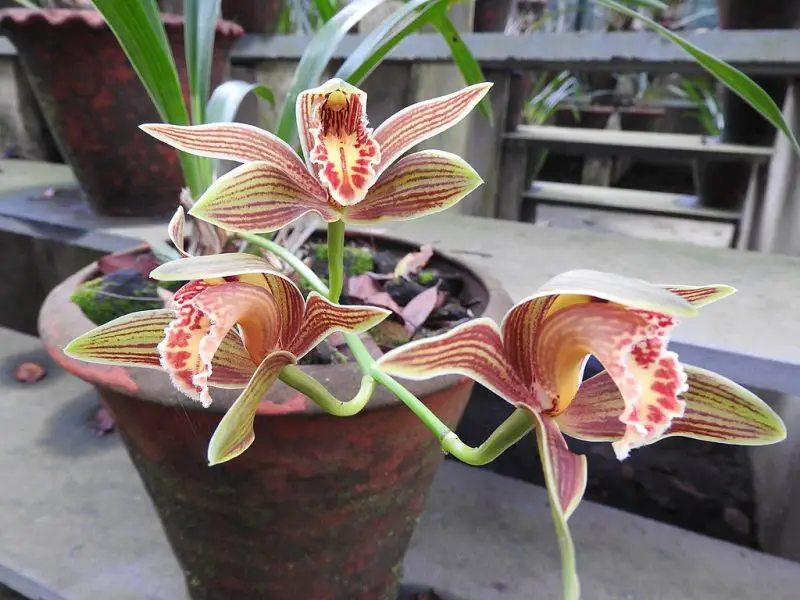
Enduring Elegance
Cymbidium orchids are cherished for their spectacular, long-lasting flowers and adaptability in various floral arrangements.
Their blooms, which can last up to two months, come in a vibrant palette of colors, making them a favorite in the world of floristry.
The resilience of their flowers, coupled with the plants’ architectural foliage, adds a touch of class to any setting.
Light: Bright but Gentle
Cymbidiums prefer bright light but need protection from the harsh midday sun.
A spot that offers morning light or late afternoon sun is ideal.
If leaves turn yellow or show signs of scorching, it’s a cue that the light may be too intense.
Temperature: Cool Comfort
These orchids enjoy cooler conditions, especially at night, which are crucial for initiating bud formation.
Daytime temperatures should range from 65-75°F (18-24°C), dropping to 50-60°F (10-15°C) at night.
This temperature differential is key to a healthy, blooming Cymbidium.
Watering: Balance is Best
Consistent moisture is vital for Cymbidium orchids, but they do not appreciate ‘wet feet.’
Allow the top inch of the potting medium to dry out before watering again.
During the growth season (spring and summer), they’ll need more frequent watering, but this should be reduced in the cooler months.
Feeding: Regular and Balanced
A half-strength balanced fertilizer should be applied every other week during the active growth period.
Cymbidiums will benefit from a high-nitrogen fertilizer in the late winter to early spring and a high-phosphorus formula in the late summer to encourage flower spike development.
By adhering to these guidelines, your Cymbidium orchids will not only thrive but will reward you with a bounty of blooms.
Their forgiving nature and stunning floral displays make them an excellent choice for orchid enthusiasts of all skill levels.
Cypripedium Orchids: Nature’s Slippers
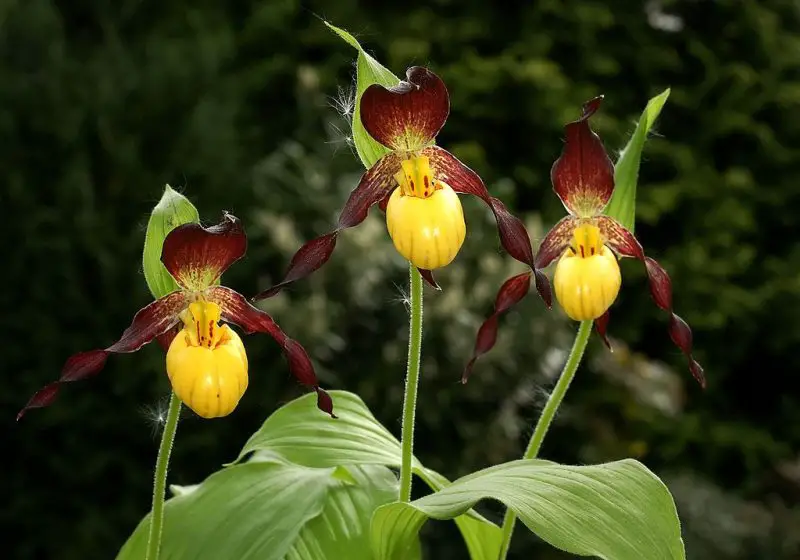
Cypripedium orchids, with their distinct slipper-shaped blooms, are a botanical marvel and a collector’s dream.
These terrestrial beauties, often referred to as lady’s slipper orchids, have a charm that is as unique as their floral pouch.
They are a testament to nature’s creativity, with intricate patterns and vibrant colors that beckon admiration.
In the garden, they not only add an exotic touch but also become a focal point that sparks conversation and awe.
Adapting to the Outdoors
Cypripedium orchids are one of the few orchids that can be grown outside in temperate climates.
They are hardy plants that, once established, can withstand cold winters and thrive in the ground.
- Climate Compatibility: Ensure your climate is suitable for growing Cypripedium orchids outdoors. They generally prefer areas with cold winters and temperate summers.
- Planting Location: Choose a location that mimics their natural habitat—dappled shade under trees or shrubs is ideal. Avoid direct sunlight and deep shade.
Soil and Planting
The right soil conditions are crucial for the successful cultivation of Cypripedium orchids in your garden.
- Soil Requirements: They require well-draining soil rich in organic matter. Amend garden soil with compost and other organic materials to improve drainage and fertility.
- Planting Depth and Spacing: Plant the rhizomes shallowly and provide ample space for growth. Overcrowding can lead to poor air circulation and increased disease pressure.
Watering and Mulching
Cypripedium orchids need consistent moisture throughout the growing season but cannot tolerate waterlogged soil.
- Watering Schedule: Water regularly to maintain evenly moist soil, especially during dry spells.
- Mulching: Apply a layer of organic mulch to conserve moisture, regulate soil temperature, and reduce weed competition.
Fertilization and Care
While Cypripedium orchids are not heavy feeders, they do benefit from occasional fertilization and regular care.
- Fertilizer Use: Apply a balanced, slow-release fertilizer in the spring to support healthy growth.
- Regular Monitoring: Check the plants regularly for signs of pests or disease, and take prompt action if any issues arise.
Preservation and Protection
With some species of Cypripedium being rare and endangered, cultivation and preservation in home gardens can play a role in their conservation.
- Support Conservation: Participate in conservation efforts by cultivating nursery-propagated plants and avoiding wild-collected specimens.
- Encourage Biodiversity: Grow a variety of Cypripedium species to support genetic diversity and ecosystem health.
By following these strategies and embracing the unique requirements of Cypripedium orchids, gardeners can enjoy the beauty and contribute to the preservation of these remarkable plants.
Dendrobium Orchids: A Spectrum of Splendor

Dendrobium orchids, with their impressive diversity, are a testament to the adaptability and beauty of the orchid family.
This genus encompasses species that vary widely in size, color, and growth habit, making them a fascinating group for orchid enthusiasts.
From the delicate, miniature blooms of Dendrobium kingianum to the large, vibrant flowers of Dendrobium phalaenopsis, there’s a Dendrobium for every taste and preference.
Light: A Delicate Balance
Proper lighting is crucial for Dendrobium orchids to thrive and bloom.
- Light Requirements: Most Dendrobium species prefer bright, indirect light. An east-facing window or a shaded south- or west-facing window is ideal.
- Avoid Direct Sunlight: Protect Dendrobiums from the harsh midday sun, which can scorch their leaves. Use sheer curtains or a light shade to filter the sunlight.
Watering: Consistency is Key
Watering needs can vary among Dendrobium species, but a general rule applies.
- Watering Frequency: During the active growing season (spring and summer), water Dendrobium orchids regularly to keep the potting medium moist but not soggy.
- Reduce Watering: In the cooler, dormant months (fall and winter), reduce watering frequency. Allow the potting medium to dry out slightly between waterings.
Temperature: Adapting to Variance
Dendrobium orchids can adapt to a range of temperatures, but certain guidelines should be followed.
- Warm Days, Cool Nights: Most Dendrobiums prefer warmer daytime temperatures (65-85°F or 18-29°C) and cooler nighttime temperatures (55-65°F or 13-18°C).
- Seasonal Fluctuations: Some species, like Dendrobium nobile, require a distinct drop in temperature to initiate blooming. Research the specific needs of your Dendrobium species.
Humidity and Air Circulation
Maintaining adequate humidity and air circulation is essential for the health of Dendrobium orchids.
- Humidity Levels: Aim for a humidity level of 50-70%. Use a humidity tray or a room humidifier to increase humidity if necessary.
- Air Circulation: Ensure good air circulation around the plants to prevent fungal and bacterial diseases. A gentle fan can help circulate the air.
Fertilization: Nutrient Support
Regular fertilization is important for the growth and blooming of Dendrobium orchids.
- Fertilizer Type: Use a balanced orchid fertilizer (e.g., 20-20-20) during the growing season.
- Frequency: Fertilize every two weeks during active growth and reduce to once a month during the dormant period.
By understanding the diverse needs of Dendrobium orchids and providing the appropriate care, you can enjoy the stunning array of colors and forms that this genus has to offer.
Whether you’re drawn to the subtle beauty of the miniature species or the bold elegance of the larger hybrids, Dendrobium orchids are sure to add a touch of exotic charm to your orchid collection.
Dracula Orchid Care (Dracula simia)
Dracula orchids, also known as monkey face orchids, are a captivating group of epiphytes native to the moist forests of western Colombia and Ecuador.
With approximately 124 recognized species, these orchids are celebrated for their unique, other-worldly flowers that often resemble a monkey’s face, especially the well-known Dracula simia.
Temperature:
Dracula orchids prefer cool to warm conditions, with most species thriving in the cooler side of intermediate temperatures.
It’s crucial to know the specific species you’re growing, as this will guide your temperature management.
Light:
These orchids enjoy bright shade. Direct sunlight should be avoided to prevent leaf burn and overheating.
Water and Humidity:
High humidity is essential for Dracula orchids, as they lack pseudobulbs and should never be allowed to dry out completely.
They are sensitive to dissolved salts, so using water of excellent quality is vital. Regular misting can help maintain the required humidity levels.
Fertilizer:
A dilute, balanced fertilizer (½ to ¼ strength) should be applied every other week.
It’s important to flush the potting medium thoroughly between fertilizer applications to prevent salt accumulation, which these plants are particularly intolerant of.
Potting:
Due to their pendant inflorescences, Dracula orchids are best grown in baskets or mounted.
Sphagnum moss, tree fern fiber, and perlite are excellent potting mediums that provide the necessary aeration and moisture retention.
By providing the right care, you can enjoy the intriguing beauty of Dracula orchids in your collection.
For more detailed information on growing these fascinating plants, check out our article on How to Grow Monkey Face Orchid.
Encyclia Orchids: Effortless Elegance

Encyclia orchids, with their distinctive cockleshell-shaped flowers and ease of care, are a delight for both novice and experienced orchid enthusiasts.
These charming orchids are known for their long-lasting blooms and adaptability, making them a popular choice for indoor cultivation.
Light: Bright and Indirect
Proper lighting is essential for the healthy growth and flowering of Encyclia orchids.
- Light Requirements: Encyclia orchids thrive in bright, indirect light. A north- or east-facing window is ideal, providing ample light without the risk of direct sun exposure.
- Avoid Direct Sunlight: Protect the plants from the harsh midday sun, which can cause leaf burn and stress the orchids.
Watering: Moderate and Consistent
Encyclia orchids prefer a balance when it comes to moisture.
- Watering Frequency: Water the orchids thoroughly when the potting medium begins to dry out, typically once a week. Adjust the frequency based on temperature and humidity levels.
- Avoid Overwatering: Ensure good drainage to prevent waterlogged conditions, which can lead to root rot.
Temperature: Warm and Cozy
Encyclia orchids enjoy a warm environment, similar to their natural tropical habitat.
- Daytime Temperatures: Aim for daytime temperatures between 70-85°F (21-29°C).
- Nighttime Temperatures: Slightly cooler nighttime temperatures, around 60-70°F (16-21°C), are beneficial for the orchids’ growth.
Humidity: Tropical Atmosphere
Maintaining adequate humidity levels is crucial for Encyclia orchids.
- Humidity Levels: Aim for a humidity level of 40-60%. Use a humidity tray or a room humidifier to increase humidity in dry environments.
- Air Circulation: Ensure good air circulation around the plants to prevent disease and promote healthy growth.
Fertilization: Gentle Nourishment
Regular fertilization supports the growth and blooming of Encyclia orchids.
- Fertilizer Type: Use a balanced orchid fertilizer (e.g., 20-20-20) diluted to half strength.
- Frequency: Fertilize every two weeks during the active growing season and reduce to once a month during the dormant period.
By following these care tips, your Encyclia orchids will reward you with their unique and beautiful blooms.
Their ease of care makes them an excellent choice for adding a touch of tropical elegance to your home or orchid collection.
Macodes Petola (Jewel Orchid): A Gem Among Orchids
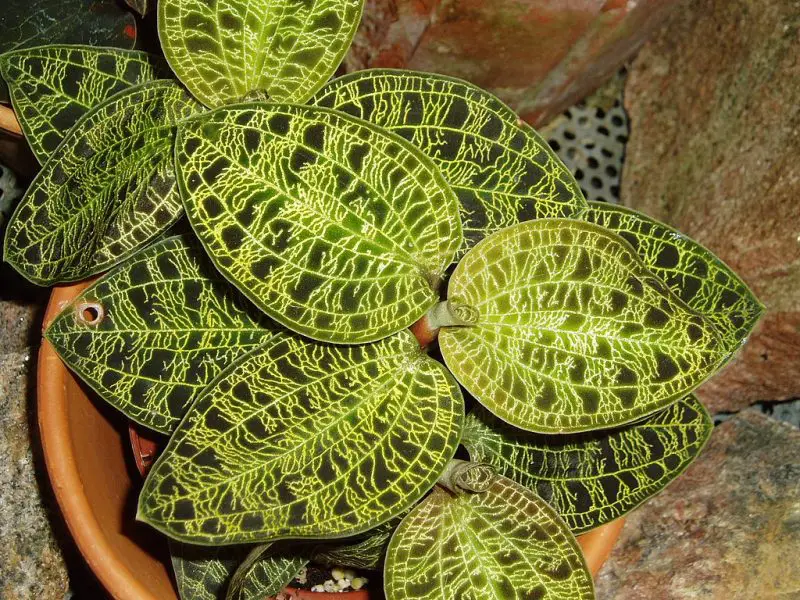
Macodes Petola, commonly known as the Jewel Orchid, is treasured for its mesmerizing, jewel-like leaves rather than its flowers.
The intricate network of golden veins on dark, velvety leaves creates a stunning visual effect that captivates all who see it.
Unlike most orchids, the allure of the Jewel Orchid lies in its foliage, making it a unique addition to any plant collection.
Light: Soft and Diffused
The Jewel Orchid thrives in low to medium light conditions, making it an ideal choice for indoor environments.
- Light Requirements: Provide bright, indirect light or partial shade. Avoid direct sunlight, which can scorch the delicate leaves.
- Artificial Lighting: If natural light is insufficient, fluorescent or LED grow lights can be used to supplement the light needs of the plant.
Watering: Evenly Moist
Macodes Petola prefers consistent moisture but does not tolerate waterlogged conditions.
- Watering Frequency: Water the plant when the top inch of the soil feels dry to the touch. Ensure that the potting medium is evenly moist but not soggy.
- Humidity: Maintain high humidity levels, around 60-70%, to mimic the Jewel Orchid’s natural tropical habitat. A humidity tray or a room humidifier can help achieve the desired humidity.
Temperature: Warm and Stable
The Jewel Orchid enjoys warm temperatures typical of its native environment.
- Ideal Temperature Range: Maintain daytime temperatures between 70-85°F (21-29°C) and nighttime temperatures no lower than 60°F (16°C).
Soil and Potting: Rich and Well-Draining
A suitable potting mix and proper potting techniques are crucial for the health of the Jewel Orchid.
- Potting Mix: Use a well-draining, rich organic potting mix. A blend of peat moss, perlite, and bark works well for ensuring adequate drainage and moisture retention.
- Repotting: Repot the Jewel Orchid every 1-2 years or when the potting mix begins to break down. Choose a pot that is slightly larger than the root ball to allow for growth.
Feeding: Light and Balanced
Fertilize the Jewel Orchid sparingly to provide essential nutrients without overwhelming the plant.
- Fertilizer Type: Use a balanced, water-soluble fertilizer diluted to quarter strength.
- Frequency: Fertilize once a month during the active growing season (spring and summer) and reduce to once every two months during the dormant period (fall and winter).
Caring for a Macodes Petola (Jewel Orchid) is a rewarding experience that brings a touch of nature’s artistry into your home.
With proper care, this terrestrial orchid will continue to dazzle with its captivating foliage for years to come.
Masdevallia Orchids: Cool-Climate Wonders
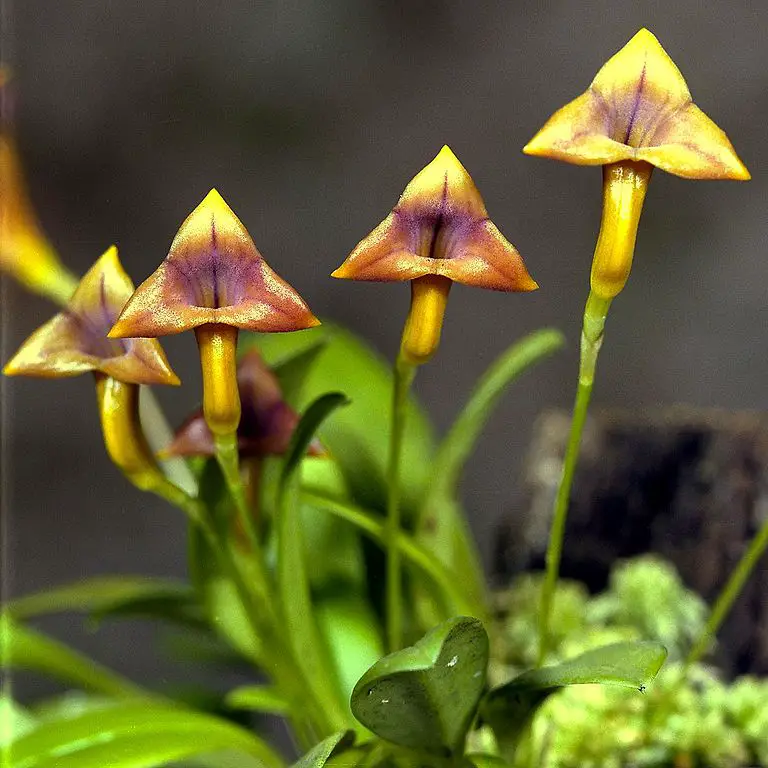
Masdevallia orchids, with their striking, often triangular flowers, are a testament to the diverse beauty of the orchid family.
These orchids are native to the cool, misty cloud forests of the Andes, making them well-suited to cooler climates.
Their unique flowers, which come in a variety of vibrant colors, are a highlight in any orchid collection.
Light: Gentle and Filtered
Masdevallia orchids prefer lower light levels than many other orchids.
- Light Requirements: Provide bright, indirect light or partial shade. Avoid direct sunlight, which can damage the leaves.
- Ideal Placement: A north-facing window or a shaded east- or west-facing window is a good location for these orchids.
Temperature: Cool and Consistent
Maintaining the right temperature is crucial for the well-being of Masdevallia orchids.
- Daytime Temperatures: Aim for 65-75°F (18-24°C) during the day.
- Nighttime Temperatures: Cooler nights, around 55-60°F (13-15°C), are essential for these orchids to thrive.
Humidity: High and Steady
Masdevallia orchids require high humidity levels to mimic their natural cloud forest habitat.
- Humidity Levels: Aim for 70-80% humidity. Use a humidity tray, or room humidifier, or place the orchid in a well-lit bathroom to increase humidity.
- Air Circulation: Ensure good air circulation around the plants to prevent fungal diseases while maintaining high humidity.
Watering: Consistent Moisture
These orchids prefer to be kept consistently moist but not waterlogged.
- Watering Frequency: Water regularly to keep the potting medium evenly moist. Reduce watering slightly in winter.
- Water Quality: Use rainwater, distilled water, or reverse osmosis water to avoid mineral buildup.
Potting Medium: Well-Draining
A suitable potting medium is essential for the health of Masdevallia orchids.
- Potting Mix: Use a well-draining mix, such as fine-grade fir bark or sphagnum moss, to ensure good aeration and moisture retention.
- Repotting: Repot every 1-2 years or when the potting medium starts to break down.
Feeding: Light and Balanced
Fertilize Masdevallia orchids with a balanced, diluted fertilizer to support their growth.
- Fertilizer Type: Use a balanced orchid fertilizer (e.g., 20-20-20) diluted to one-quarter strength.
- Frequency: Fertilize once a month during the growing season and reduce to once every two months in the dormant period.
By providing the right environment and care, Masdevallia orchids can thrive and add a unique and exotic touch to your orchid collection.
Their distinctive flowers and preference for cooler climates make them an intriguing choice for orchid enthusiasts looking to diversify their collections.
Oncostele Orchids: Hybrid Wonders
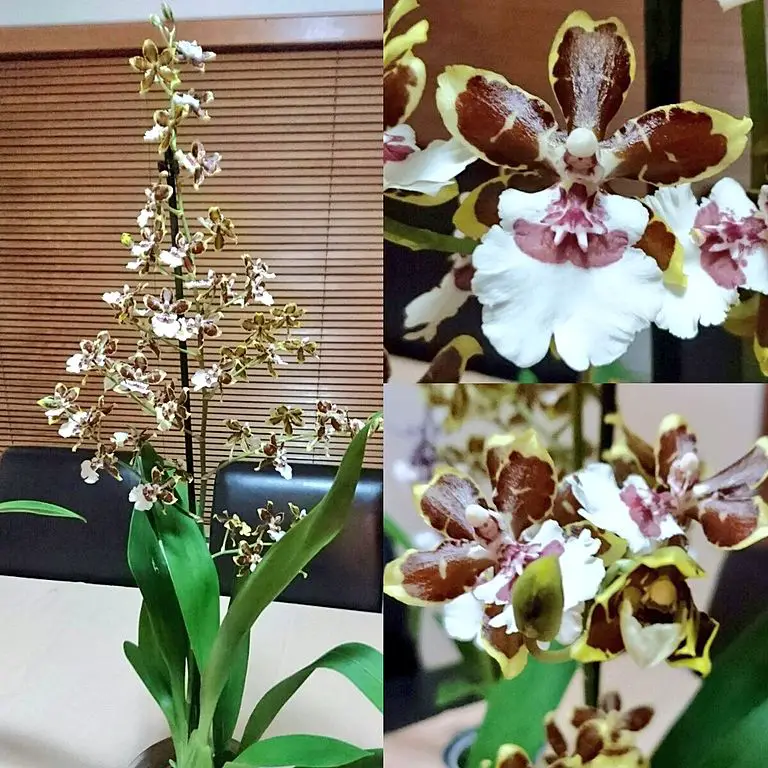
Oncostele orchids, hybrids resulting from the cross between Oncidium and Rhynchostele species, are celebrated for their unique beauty and wide range of colors.
These orchids are known for their vibrant blooms and intricate patterns, making them a favorite among orchid enthusiasts.
The care for Oncostele orchids is similar to that of their Oncidium parentage, with some adjustments to accommodate their hybrid nature.
Light: Bright and Cheerful
Oncostele orchids thrive in bright, indirect light, which is essential for healthy growth and vibrant flowering.
- Light Requirements: Place them in an area that receives bright, filtered light, such as near an east- or west-facing window.
- Avoid Direct Sunlight: Protect the orchids from direct midday sun, which can cause leaf burn.
Temperature: Warm and Cozy
These hybrids prefer warm temperatures, similar to their Oncidium parentage.
- Daytime Temperatures: Maintain temperatures between 70-85°F (21-29°C) during the day.
- Nighttime Temperatures: A slight drop in temperature at night, around 60-65°F (16-18°C), is beneficial for flower development.
Humidity: Moist and Comfortable
Oncostele orchids enjoy a humid environment, which helps mimic their natural tropical habitat.
- Humidity Levels: Aim for 50-70% humidity. Use a humidity tray, or room humidifier, or place the orchid in a well-lit bathroom to increase humidity.
- Air Circulation: Ensure good air circulation around the plants to prevent fungal diseases while maintaining high humidity.
Watering: Regular and Even
Keeping the potting medium consistently moist but not soggy is key for Oncostele orchids.
- Watering Frequency: Water the orchids when the top inch of the potting medium feels dry to the touch.
- Drainage: Ensure the pot has adequate drainage to prevent waterlogging and root rot.
Potting Medium: Well-Draining
A suitable potting medium is crucial for the health of Oncostele orchids.
- Potting Mix: Use a well-draining orchid mix, such as a combination of bark, perlite, and sphagnum moss.
- Repotting: Repot every 1-2 years or when the potting medium starts to break down.
Feeding: Balanced Nutrition
Regular fertilization supports the growth and blooming of Oncostele orchids.
- Fertilizer Type: Use a balanced orchid fertilizer (e.g., 20-20-20) diluted to half strength.
- Frequency: Fertilize every two weeks during the active growing season and reduce to once a month during the dormant period.
By following these tips for successful growth and flowering, your Oncostele orchids will flourish, adding a splash of color and unique beauty to your orchid collection.
Their hybrid vigor and diverse color palette make them a rewarding choice for orchid enthusiasts looking to expand their collections.
Paphiopedilum Orchids: Slipper Elegance
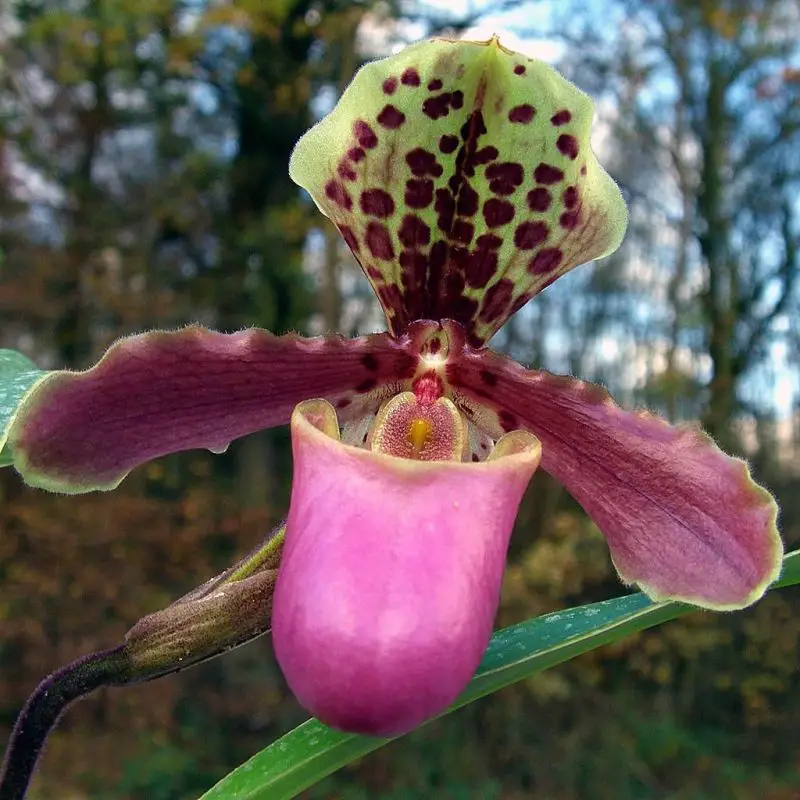
Paphiopedilum orchids, commonly known as slipper orchids, are renowned for their exquisite beauty and unique floral structure.
The slipper-shaped pouch and striking dorsal sepals make these orchids stand out in any collection.
Their unique blooming habits and diverse range of colors and patterns add an intriguing dimension to the world of orchids.
Light: Gentle and Filtered
Proper lighting is crucial for the growth and flowering of Paphiopedilum orchids.
- Light Requirements: These orchids prefer moderate, diffused light. An east- or west-facing window with sheer curtains or a lightly shaded south-facing window is ideal.
- Avoid Direct Sunlight: Protect Paphiopedilum orchids from the harsh midday sun to prevent leaf burn.
Temperature: Comfortable Range
Paphiopedilum orchids enjoy a moderate temperature range that mimics their natural habitat.
- Daytime Temperatures: Aim for 70-80°F (21-27°C) during the day.
- Nighttime Temperatures: Slightly cooler nights, around 60-65°F (16-18°C), are beneficial for these orchids.
Humidity: Consistently Moist
Maintaining adequate humidity levels is essential for the health of Paphiopedilum orchids.
- Humidity Levels: Aim for 40-60% humidity. Use a humidity tray or a room humidifier to increase humidity in dry environments.
- Air Circulation: Ensure good air circulation around the plants to prevent fungal diseases while maintaining high humidity.
Watering: Even Moisture
Paphiopedilum orchids prefer consistent moisture but do not like to sit in waterlogged soil.
- Watering Frequency: Water the orchids when the top inch of the potting medium feels dry to the touch. Avoid letting the roots dry out completely.
- Drainage: Ensure the pot has adequate drainage to prevent waterlogging and root rot.
Potting Medium: Well-Draining
A suitable potting medium is crucial for the health of Paphiopedilum orchids.
- Potting Mix: Use a well-draining orchid mix, such as a combination of bark, perlite, and sphagnum moss.
- Repotting: Repot every 1-2 years or when the potting medium starts to break down.
Feeding: Regular Nutrition
Regular fertilization supports the growth and blooming of Paphiopedilum orchids.
- Fertilizer Type: Use a balanced orchid fertilizer (e.g., 20-20-20) diluted to half strength.
- Frequency: Fertilize every two weeks during the active growing season and reduce to once a month during the dormant period.
By following these detailed care instructions, your Paphiopedilum orchids will thrive, showcasing their unique slipper-shaped blooms and adding a touch of elegance to your orchid collection.
With proper care, these exquisite orchids will continue to captivate and delight for years to come.
Phalaenopsis Orchids: The Moth Orchid A Pillar of Indoor Gardening
Phalaenopsis orchids, endearingly termed moth orchids, stand out with their symmetrical blooms and a wide array of colors.
Their long, arching inflorescences and large, leathery leaves make them a focal point in any indoor garden.
Native to tropical climates, they’ve adapted well to home environments, making them a popular choice for enthusiasts and beginners alike.
Light
These orchids thrive in moderate lighting conditions. They prefer bright, indirect sunlight, with east or shaded south-facing windows being ideal.
Direct sunlight can damage the leaves, while too little light may prevent them from blooming.
Temperature
Comfortable in the same temperatures most people enjoy, Phalaenopsis orchids prefer a range between 65-80°F (18-27°C) during the day and no less than 60°F (15°C) at night.
Avoid sudden temperature changes to prevent bud drop.
Humidity Levels
A humidity level of 50-70% is ideal for Phalaenopsis orchids. To achieve this, place the orchid on a humidity tray or group it with other plants.
In drier climates, a room humidifier can help maintain the necessary moisture in the air.
Watering
Water once a week, allowing the potting mix to dry out slightly between watering sessions.
Use lukewarm water and avoid letting water sit in the crown or between the leaves, as this can lead to rot.
Potting Medium
A well-draining potting medium is vital. A mix of bark, perlite, and charcoal is often used to provide the right balance of moisture retention and aeration.
Replace the potting medium every 1-2 years to prevent breakdown and root issues.
Feeding
Fertilize your Phalaenopsis orchids with a balanced, water-soluble orchid fertilizer at half-strength every other week during the growing season.
Reduce feeding to once a month during the dormant period.
Phalaenopsis Orchids the Quintessential Indoor Plant
Phalaenopsis orchids are the quintessential indoor plant for a touch of elegance and natural beauty.
With their forgiving nature and minimal care requirements, they can provide a spectacular display of blooms, adding life and color to any indoor space.
By following these care tips, you can enjoy the splendor of these orchids for many seasons to come.
Vanda Orchids: Tropical Aerial Beauties
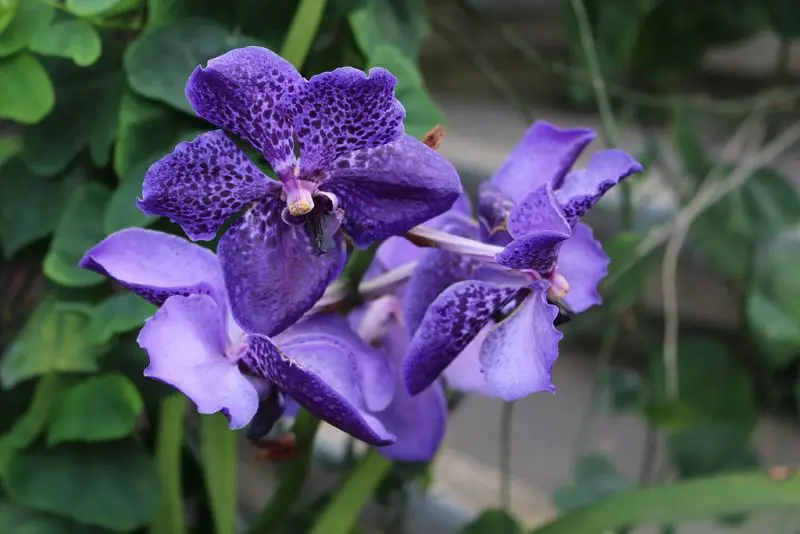
Vanda orchids are a stunning group of tropical orchids known for their vibrant colors, large blooms, and aerial root systems.
These orchids are epiphytes, meaning they naturally grow on trees in their native habitats, absorbing moisture and nutrients from the air.
Their unique growth habit and striking flowers make them a favorite among orchid enthusiasts.
Light: Bright and Abundant
Vanda orchids thrive in bright, indirect light, which is crucial for their growth and flowering.
- Light Requirements: Place Vanda orchids in a spot that receives bright, filtered light for most of the day. A south-facing window with sheer curtains or a spot under 30-40% shade cloth is ideal.
- Avoid Direct Sunlight: Protect the orchids from direct midday sun, especially in hot climates, to prevent leaf burn.
Temperature: Warm and Consistent
These tropical orchids prefer consistently warm temperatures.
- Daytime Temperatures: Maintain temperatures between 75-95°F (24-35°C) during the day.
- Nighttime Temperatures: A slight drop in temperature at night, around 65-75°F (18-24°C), is beneficial for the orchids’ growth.
Humidity: High and Steady
High humidity is essential for Vanda orchids, mimicking their natural tropical environment.
- Humidity Levels: Aim for 60-80% humidity. Use a humidifier, place the orchid in a well-lit bathroom, or mist the aerial roots regularly to maintain high humidity levels.
- Air Circulation: Ensure good air circulation around the plants to prevent fungal diseases and promote healthy growth.
Vanda Orchids: Soil vs. Baskets
Vanda orchids are epiphytes, meaning they naturally grow on trees and absorb moisture and nutrients from the air.
In cultivation, they are often grown in baskets or mounted on slabs to mimic their natural growing conditions.
While they can be grown in a potting medium, their unique root system and need for air circulation make basket or bare-root culture more common.
Growing Vanda Orchids in Baskets:
- Baskets: Wooden or wire baskets are ideal for Vanda orchids as they provide excellent air circulation to the roots. Baskets should have large openings to allow the roots to grow freely.
- Mounting: Some growers prefer to mount Vanda orchids on slabs of cork or tree fern. This method closely mimics their natural epiphytic growth habit.
- Root Care: Vanda roots should be misted or soaked regularly to ensure they receive adequate moisture. In humid environments, the roots can absorb moisture from the air.
Potting Vanda Orchids:
- Potting Medium: If you choose to pot Vanda orchids, use a very coarse, well-draining medium such as large-grade bark or charcoal. The potting mix should allow for quick drainage and ample airflow to the roots.
- Pot Type: Use a pot with plenty of drainage holes. Some growers use clear pots to allow sunlight to reach the roots, which can be beneficial for photosynthesis.
- Watering: Potted Vanda orchids will require more frequent watering than those grown in baskets or mounted, as the potting medium will dry out more quickly.
Regardless of whether you grow Vanda orchids in baskets or pots, the key is to ensure that their roots have access to plenty of air and are not constantly wet.
By providing the right conditions, your Vanda orchids will thrive and reward you with their stunning blooms.
Watering: Frequent and Thorough
Vanda orchids have a high water requirement due to their aerial root system.
- Watering Frequency: Water the orchids once or twice a day during hot, dry weather. Reduce watering to every other day or as needed in cooler, more humid conditions.
- Soaking Method: Some growers prefer to soak Vanda orchids in water for 15-30 minutes once a week to thoroughly hydrate the roots.
Feeding: Regular and Balanced
Regular fertilization is important for the growth and flowering of Vanda orchids.
- Fertilizer Type: Use a balanced orchid fertilizer (e.g., 20-20-20) diluted to quarter or half strength.
- Frequency: Fertilize every week during the active growing season and reduce to every other week during the dormant period.
By providing the right care and environment, your Vanda orchids will flourish, producing stunning blooms that add a touch of the tropics to your home or greenhouse.
Their vibrant colors and unique growth habit make them a captivating addition to any orchid collection.
Conclusion: Orchid Types Embracing Orchid Diversity
The world of orchids is a vast and diverse realm, filled with an array of species and hybrids, each with its own unique beauty and care requirements.
From the cool-loving Masdevallia to the warmth-preferring Vanda, the diversity of orchids offers something for every enthusiast.
Understanding the specific needs of each type, from light and temperature to humidity and watering, is key to nurturing these exquisite plants.
Exploring the Orchid World
We encourage you to delve into the fascinating world of orchids, exploring the different types and discovering the ones that resonate with you.
Whether you’re drawn to the intricate patterns of a Paphiopedilum or the vibrant colors of a Cattleya, there’s an orchid out there waiting to captivate your heart.
A Journey of Floral Splendor
Embrace the diversity, learn about their unique care requirements, and embark on a rewarding journey filled with floral splendor.
The world of orchids is a testament to nature’s beauty and complexity, and it’s yours to explore and cherish.
Resources for Orchid Enthusiasts
Exploring the world of orchids can be a rewarding journey, and having access to reliable resources can enhance your understanding and appreciation of these beautiful plants.
Here are some websites that offer valuable information on orchid care, cultivation, and conservation:
- American Orchid Society (AOS): www.aos.org
- A premier resource for orchid enthusiasts, providing comprehensive care guides, cultural information, and a wealth of articles on various orchid genera.
- Royal Horticultural Society (RHS): www.rhs.org.uk
- Offers detailed advice on orchid care, including tips for growing different types of orchids and dealing with common pests and diseases.
- Orchid Conservation Alliance (OCA): www.orchidconservationalliance.org
- Dedicated to the conservation of orchids and their habitats, the OCA provides information on how to support orchid conservation efforts and promote sustainable cultivation practices.
- Missouri Botanical Garden: www.missouribotanicalgarden.org
- Features an extensive plant database with information on various orchid species, including their botanical descriptions and care requirements.
- Kew Royal Botanic Gardens: www.kew.org
- Renowned for its botanical research and conservation work, Kew offers a wealth of information on orchid taxonomy, conservation, and cultivation.
By exploring these resources, you can deepen your knowledge of orchids and become a more informed and responsible orchid grower.
Whether you’re a beginner or an experienced orchid enthusiast, these websites provide valuable insights into the captivating world of orchids.
This post contains affiliate links.


